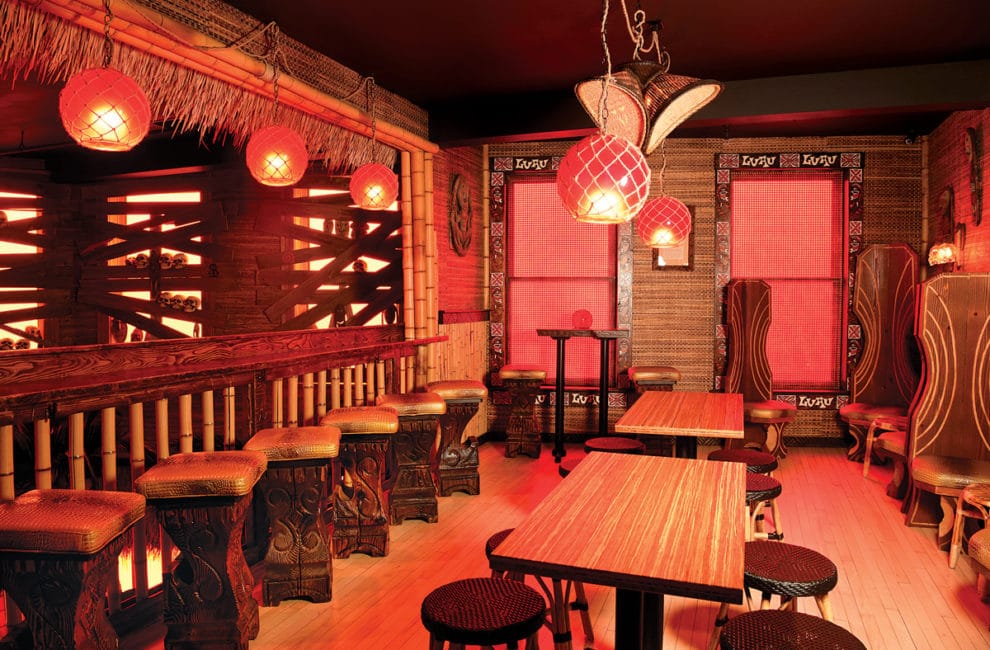
Welcome To The Jungle: Tiki Decor
As great as The Inferno Room drinks are, it’s the tiki decor that stuns most people like a blow dart. Here, see the wildest details in Fountain Square’s new watering hole.

Giant Tribal Mask
When The Inferno Room co-owners Ed Rudisell and Chris Coy began dreaming about opening a tiki bar last year, they knew they wanted a huge, scary mask to greet visitors. And when it comes to hand-carved objects inspired by Melanesian tribal art, Milwaukee-based artist Dave Hansen has basically cornered the market. The duo hired Hansen, who whittled portions of this 7-foot-long mask in front of a live audience at Boone & Crockett, a throwback Milwaukee bar.

Tribal Necklaces
A few weeks after The Inferno Room opened, a woman came in, sat at the bar, and pulled these shell necklaces from her purse. “She had purchased them from villagers in the remote regions of Papua New Guinea, and she wanted us to have them,” Rudisell says. “We’re still new on the scene, but it made me happy that she had heard of us. The collection is still growing.”

Pufferfish Lantern
Acquired from an online retailer based in Thailand, these lights (and the nearby fishing floats) represent the style most people associate with tiki.
Tiki Mugs
A lot of artisans make ceramic cups for Mai Tais and Singapore Slings. The Inferno Room wanted to produce stoneware they could sell to patrons at a reasonable price. Tiki Farm in southern California manufactures the logo skull mug ($35), and Ken Ruzic from Illinois makes the taller “drum mug” with images from the bar ($75).
Fertility Statue
While small in stature, this figure of a man holding his giant penis is hard to miss atop the back bar. “They’re a very proud people,” Coy says, laughing. When Rudisell and Coy first looked through the Edler collection, they didn’t notice what has since become a kind of mascot for the establishment. “He just happened to fit perfectly in that high-profile spot,” Coy says.
Sepik River Region Art
As the bar was coming together, Rudisell and Coy heard about a recently deceased anthropologist in Ellettsville named John Edler, who had spent much of his life in Papua New Guinea, collecting artwork. “Chris and I drove down to his house not knowing what we were going to find,” Rudisell says. “We thought it was going to be a couple of pieces. It turned out to be a pole barn full of art. Half joking, I said, ‘How much for all of it?’ His brother gave us a number, and we drove away with 400 objects.”
Skull Rack
Unlike many tiki bars, The Inferno Room has a slightly creepy, headhunter village vibe. “It spoke to us more than the beach-themed stuff you see everywhere,” Rudisell says. “It’s darker, more mysterious.” After visiting the Milwaukee Public Museum, Coy built this replica of an exhibit there with bamboo and skulls acquired from a Hollywood prop company.
The Luau Room
One of the biggest figures in tiki history hailed from Crawfordsville. Steve Crane owned The Luau in Beverly Hills in the 1950s, among the genre’s Big Three (alongside Trader Vic’s and Don the Beachcomber). This entire room, from the wood trim carved with his bar’s logo to the thatch wallcovering, is a tribute to him.

Masks
While spectacular, the masks from Edler’s collection aren’t particularly rare. The religious symbols often were used for only a short time before new ones were produced, meaning there are thousands of them. Nevertheless, having authentic art from the area was essential for the owners. “They’re valuable to us because it allows us to create a museum you can drink in,” Rudisell says.
Read more from our
Isle of Tiki package here.









